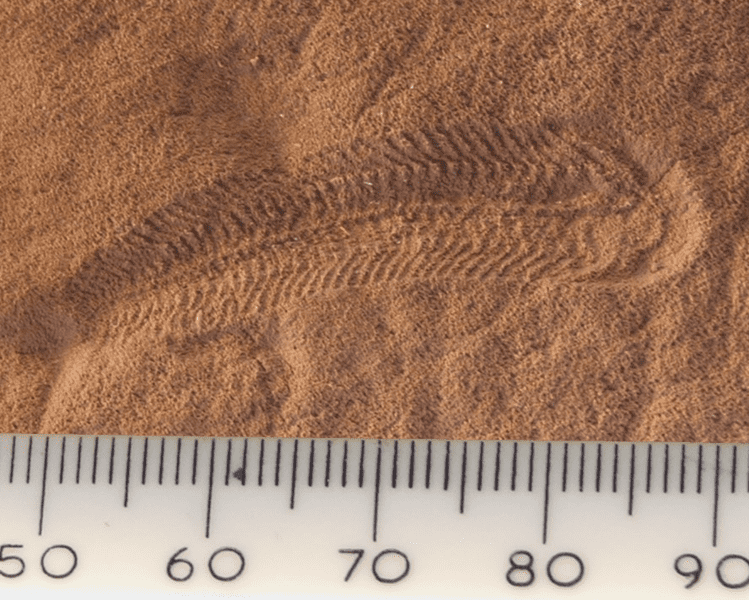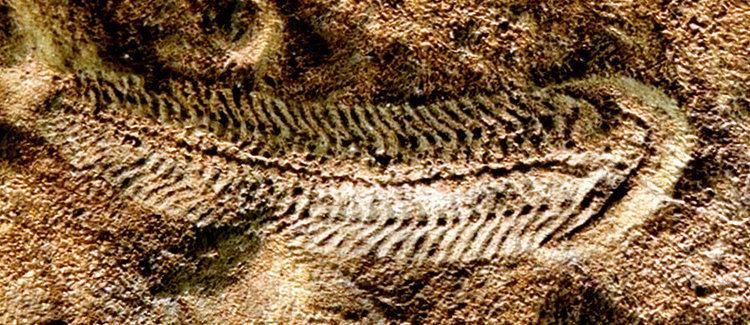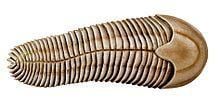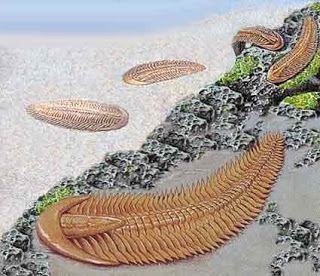Species S. floundersi | Family Sprigginidae Scientific name Spriggina floundersi | |
Similar | ||
Prof flint s spriggina spriggina
Fossils of Spriggina are known from the Ediacaran period, around 550 million years ago. The segmented organism reached about 3–5 cm in length and may have been predatory. Its bottom is covered with two rows of tough interlocking plates, while one row covered its top; its front few segments fused to form a "head", which may have borne eyes and antennae.
Contents
- Prof flint s spriggina spriggina
- About spriggina
- Morphology
- Fossil occurrences
- Affinity
- History
- References

Spriggina's affinity is currently unknown; it has been classified as an annelid worm, a rangeomorph-like frond, a variant of Charniodiscus, a proarticulatan, or an arthropod perhaps related to the trilobites, or even an extinct phylum. Lack of known segmented legs or limbs, and glide reflection instead of symmetric segments, suggest an arthropod classification is premature despite some superficial resemblance.

Spriggina is the official fossil emblem of South Australia. It has been found nowhere else.
About spriggina
Morphology

Spriggina grew to around three centimetres in length, and was approximately oblong. The organism was segmented, with no fused segments, with the segments sometimes being curved. The upper surface of the organism was covered by one row of overlapping cuticular plates; the underside, paired plates.

The first two segments formed a "head". The front segment was the shape of a horseshoe, with a pair of depressions on its upper surface which may represent eyes. The second segment may have borne antennae. Subsequent segments bore annulations.
Some fossils have what may be a circular mouth at the centre of the semicircular head – although interpretation is hampered by the small size of the creature relative to the large grains of sandstones in which it is preserved. Legs are not preserved.
The symmetry observed is not exactly bilaterian, but appears to be a glide reflection, where opposite segments are shifted by half an interval. In some specimens the body segments tilt backwards, making roughly chevron patterns; while in others they are more or less straight. There appear to be fairly complex variations between these two extremes.
Fossil occurrences
Spriggina is known only from beds of Ediacaran age. Fossils from the Vindyhan, reliably dated to around 1,200 million years old, have been classified as Spriggina, but in all likelihood represent microbial artifacts. Spriggina possessed a tough, though uncalcified, body, evident from the fossils' preservation: always as a mould in the lower surface of the fossiliferous bed.
Affinity
Like many of the Ediacara biota, the relationship of Spriggina to other groups is unclear. It bears some similarity to the living polychaete worm Tomopteris and Amphinomidae, but its lack of chaetae, along with other lines of evidence, suggests that it cannot be placed in this phylum. It was also compared to the rangeomorphs, frondose members of the Ediacara biota that may represent a separate kingdom. While its glide symmetry may suggest otherwise, Spriggina is considered by some other researchers to be an arthropod; its superficial resemblance to the trilobites may suggest a close relationship to this class. Or this similarity can be another example of convergent evolution. Spriggina may have been predatory, and may have played a role in initiating the Cambrian transition.
History
The genus was named after Reg Sprigg who discovered the fossils of the Ediacara Hills—part of the Flinders Ranges in South Australia—and was a proponent of their recognition as multicellular organisms. Spriggina floundersi is at present the only generally accepted species in this genus. The specific name "floundersi" refers to amateur South Australian fossil hunter Ben Flounders. Spriggina ovata has now been moved into its own genus, Marywadea. Spriggia wadea is probably a junior synonym of Aspidella preserved under specific conditions.
